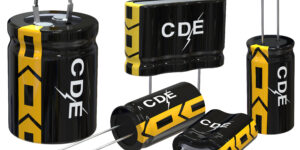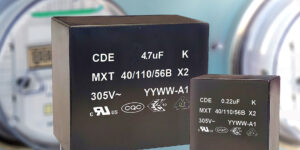Type BLH, DC Link Capacitors for Harsh Environments
Type BLH exceeds industry standards for humidity testing, AEC-Q200 qualified
Green energy and electric transportation systems have pushed explosive growth in inverter markets. Many of these applications present harsh operating environments for power electronics circuitry. Often, these applications demand a high percentage of uptime, increasing the need for highly reliable components. In response, CDE’s BLH series of DC-Link capacitors have been designed and tested to exceed the industry’s most stringent requirements for high humidity, vibration testing, and thermal cycling.
The Temperature, Humidity at Bias (THB) test exposes parts to the harsh conditions of 85 °C at 85% relative humidity with rated voltage applied. This demanding test simulates the harsh operating conditions encountered in many commercial and industrial inverter applications. Such conditions can cause non-THB rated capacitors to fail early from moisture penetration. While most capacitor makers validate their THB components for 1,000 hours under these conditions, CDE’s BLH series has been validated for 1,500 hours.
Utilizing the most advanced materials and processes, these board-mounted capacitors have been designed and tested to meet the rigors of automotive AEC-Q200 testing. Their solvent-resistant plastic case and epoxy encapsulation system are UL Recognized and meet IEC61071. Tin-plated copper RoHS-compliant terminations ensure excellent solderability. With their superior resistance to moisture and robust design, these capacitors are well suited for solar, wind, UPS, EV chargers, and other inverter applications that may be subjected to wide-ranging environmental conditions.
The series is optimized for DC link applications in medium to high-power inverters. Capacitance ranges from 1.0 to 170 µF at 450-1,200 Vdc, with high rms ripple current ratings up to 36 Arms. When operated at a 70 °C hot-spot temperature with rated voltage applied, their life expectancy is 100,000 hours.
• Optimized for inverter DC-Link Applications
• High capacitance
• High ripple current up to 36 Arms
• Self-healing and low loss
• THB 85 °C / 85 % RH, 1500h at rated voltage
• UL Listed
• AEC-Q200 Qualified

Applications Include:
DC Link for solar, EV, and other inverters that are subjected to the harshest environmental conditions, backup, UPS, portable power systems, motor drives, traction, and other transportation systems.
Find a Rep Find a Distributor
New Products
-
Released Aug, 2024
Type QAS, Arc Suppressor/Snubber Network
Type QAS will extend the operating life of electronic and electro-mechanical devices by reducing and/or eliminating the electrical arcing, noise, and EMF. These electrical conditions often cause early failures in relays, switch contacts, and solid-state components such as SCRs and TRIACs.
-
Released Mar, 2024
3 CELL DSF & DGH
Three-cell devices offer greater energy potential and power output than single or dual-cell parts in standard PCB layouts
3-cell DSF & DGH capacitors provide very fast power discharge that cannot be matched by conventional capacitors or batteries. That large capacity makes it possible to support brief power interruptions, supplement batteries, or even be used in place of batteries in many applications.
-
Released Nov, 2023
TYPE MXT, X2, EMI/RFI Suppression Capacitors, Harsh Environment
Type MXT Series Metallized Polypropylene Film Capacitor, designed to suppress conducted electromagnetic/radio frequency interference (EMI/RFI) at a circuit’s power input. These capacitors are perfect for use in harsh environments having met the demanding 85/85 THB (Temperature, Humidity, Bias) test requirements. Class X2 capacitors, like the MXT, are typically connected across the AC input to prevent interference from spreading through power lines or other devices on the same circuit.




